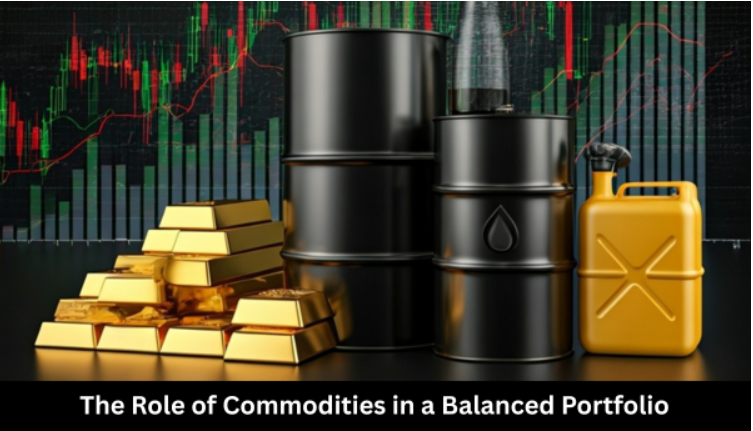The Role of Commodities in a Balanced Portfolio
In the dynamic era of investment, creating a balanced portfolio is paramount for long-term achievement. While stocks and bonds usually take centre stage in conventional investment strategies, commodities have emerged as a key player in contemporary portfolio diversification, particularly during periods of inflation, geopolitical instability, or economic turmoil.
Assets such as gold, crude oil, silver, and agricultural products offer special advantages that other asset classes cannot always provide. In this blog, we look at how commodities are part of a balanced portfolio, why they are important in 2025, and how you can begin including them, be it through crude oil trading tips or knowing how to trade gold online successfully.
Why Commodities Matter
Commodities are raw materials or basic farm products that can be purchased and sold. Commodities are further categorized into two broad groups:
- Hard commodities: Natural resources like gold, crude oil, and metals.
- Soft commodities: Farm products such as coffee, wheat, and cotton.
Investing in commodities can provide:
- Inflation Hedge: Commodity prices will appreciate as inflation goes up. Thus, commodities are an effective hedge when fiat money is losing its purchasing power.
- Portfolio Diversification: Stocks and bonds have different determinants of prices, weather conditions, geopolitical tensions, and supply chain problems. This makes the total correlation with conventional markets lower.
- International Exposure: Commodities mirror world economic developments. Investing in them provides exposure to international expansion, particularly in countries that largely rely on natural resources and are hence termed ’emerging markets.
Gold
Gold has been a test of time as the most precious and reliable asset in history. In a diversified portfolio, gold acts as a stabilizer, providing protection in times of unpredictable market fluctuations or economic recessions.
If you’re wondering how to trade gold online, the good news is that it has never been easier. Today’s traders can access gold through:
- Spot gold contracts
- Gold futures
- Gold ETFs
- Gold CFDs on online trading platforms
Benefits of Gold in Your Portfolio:
- Low correlation with equities: Gold often moves inversely to stock markets, making it a natural hedge.
- High liquidity: It’s widely traded and can be quickly converted into cash.
- Resistance to crisis: Gold does well in wars, pandemics, and recessions.
Crude Oil
Crude oil is the pulse of the world economy. Its pricing depends on geopolitical tensions, changes in supply and demand, and OPEC politics. Due to its volatile nature, oil can promise high risks as well as high rewards.
Including oil in a portfolio adds exposure to the energy sector, which behaves differently from financial markets. However, it’s important to approach oil trading strategically.
Here are some crucial tips for crude oil trading to keep in mind:
- Follow Global News: Oil prices are heavily affected by world events. Tensions in the Middle East, changes in U.S. reserves, or OPEC+ decisions can cause major price shifts overnight.
- Monitor Inventory Reports: Weekly inventory reports by the U.S. Energy Information Administration (EIA) tend to induce short-term price fluctuations. Traders utilise the data to fine-tune positions on the fly.
- Utilise Technical Analysis: Oil markets are prone to trends. Master how to interpret candlestick charts, support/resistance areas, and moving averages to determine entry and exit points.
- Control Volatility: Crude oil is very volatile. Implement stop-loss orders, do not over-leverage, and avoid emotional trading. Position sizing is key to oil trading.
A modest allocation (about 5%) to crude oil exposure can enhance your portfolio’s performance, particularly if inflation picks up or the global economy recovers from a slowdown.
Other Commodities
While gold and oil are favoured, other commodities will also play a role in a balanced portfolio:
- Silver: Provides equivalent advantage to gold with industrial use exposure.
- Copper: Excellent mechanism for investing in infrastructure and green energy themes.
- Agricultural commodities: Wheat, coffee, or soybeans can provide protection against food inflation or weather-related supply disruption.
Commodities are tradable directly (through futures and options) or indirectly through ETFs and contracts for difference (CFDs).
Conclusion
Commodities are not merely a trading vehicle. They are a foundation block of a diversified and robust portfolio. When markets get more volatile and legacy asset classes are hit by headwinds, commodities serve as a strong counterweight.Bank Account Opening
By using wise crude oil trading strategies, understanding how to trade gold online, and diversifying your exposure, you can future-proof your investment plan in 2025 and into the future.Registered Business Address






